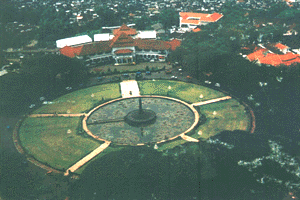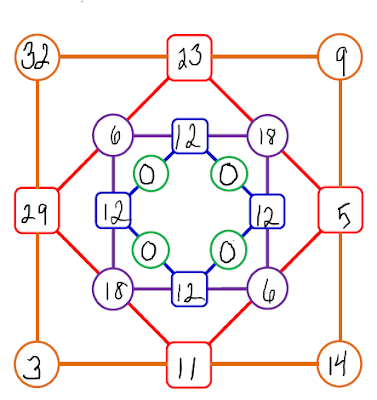Observation
Report in Class IIA SDN 179 Palembang
|
|
|
|
|
|
|
|
A.
Introduction
Mathematics was difficult material
by most of students, because teachers taught with abandon methods which not
attractive to students because the teacher just explained and the students not
involved in the learning process. That have implications for the low
performance of students in mathematics.
Mathematics as a branch of science that is structured and systematically, and have
a roles in optimizing the ability of human thinking. The purpose of mathematical learning is to trained
how to think, reasoning, and made
good conclutions. Therefore, learning mathematics is
expected to be a proper container in the formation of human thinking abilities.
And need good design learning for students. The most appropriate approach to
learning that is Realistic Mathematics Education approach Indonesia (PMRI).
For this
research, we create and develop learning process with PMRI approach. We used
learning contexts which close to the student and they easily found in their
daily life. We used one kind snack is called Hello Panda, the students usually
consumed that snack. With that context we will teach addition for three-digit
nmbers less than five hundred. Here are the steps for learning process :
B.
Design Research
Phase I: Preliminary Design
In this step, we are discuss
about topic that will be used. We used topic with standart of competency
addition and substraction for three
digit number less than 500, and the indicators
is addition three-digit numbers without saving techniques.
The purpose for the learning activities are students have ability to addition three-digit numbers without
saving techniques. After that, we are discuss with teachers
about teaching schedule, a class of conditions
and the equipment and materials used in
the learning process.
a. Activity I
: introduction about big box hello panda, small box hello panda, small panda.
The students introduced to
the problems context related with place and value integer. In this activity,
teacher showed small box helllo panda to the tudents. Most of students familiar
with this snack because they almost consumed this snack. The teacher explained
if the small box hello panda contained 10 small panda. Teacher showed if the
big box hello panda contained 10 small box hello panda. After that teacher give
questions to the students. If the small box hello panda contained 10 small
panda it means represent what? If the big box hello panda contained 10 small
box hello panda and 100 small panda, represent what? The teacher give that
question have purpose to lead students concept about place value hundreds, tens
and ones.
figure 1. Hello Panda snack
b. Activity II
: the students untwist big box hello panda, small box hello panda, and small
hello panda.
The students
answers the question from LKK with untwist big box hello panda, small box hello
panda, and small panda. The purpose of this activity is the students capable to clasify the kinds of
hello panda and related to the place value.
c. Activity
III : the students answers the question with drawing big box hello panda, small
box hello panda, and small panda in the answer sheet.
The students
answers the question from LKK with drawing the big box hello panda, small box
hello panda, and small panda in the answers sheet. The purpose of this activity
is the students capable to understand if the big box represent hundreds, small
box represent tens and small box represent ones.
d. Activity IV
The students
lead to found the idea to solve the addition problems three-digits numbers less
than 500 in the LKK with big box hello panda, small box hello panda, and small
panda.
e. Activity V
In this activity the
students solve the question in the LKK unassisted big box hello panda, small
box hello panda, and small panda. The goal for this activity is make students
capable to solve the addtion three digits numbers less than 500 without saving.
Phase
II : Teaching Experiment
The Implementation of learning that we have compiled
held on 18 September 2013 in the class II A SDN 179 Palembang for 2 x 35 minutes. The teachers, researchers and students active to participate in this
activity.
The process of learning activity start with remaind
students about place value for two digits numbers. After that teacher explained
about the goal of the learning process on that day. The teacher used the
learning context which is closed with the students. The manipulative for the
learning activity is big box hello panda, small box hello panda, small panda and addition board.
figure 2.
the teacher showed the hello panda context
Next,
teacher asked to the students amount of big box hello panda, small box hello
panda, and small panda. The students answers the question with enthusiasm, they
found if the big box hello panda contained 10 small box hello panda and 100
small panda and they conclude if the big box hello panda represent.
After
that the teacher divide the students to small group, ecah group contained 3 – 4
students. The purpose of this activity is teach students to work in group. The
teacher shared Lembar Kerja Kelompok or LKK to each groups. And teacher
explained the procedure in the LKK. The firs activity, students untwist amount
of big box hellp panda, small box hello panda, and small panda. There were some
groups have a some problems, they scrambling to fill LKK. Hence, the teacher
give more LKK to them. Almost all of the student enthusiasm with the learning
activity on that day.
figure 3. the students work
in group
after
the students wok in goups, the teacher asked to the students to showed their
result in front of class with the addition board. The teacher choosed the
students randomly for every groups. The teachers choosed two students from
every groups. But, because the students rarely speaking in front of class,
teacher help them with given question and they solve with the addition board.
And they showed they answers to their friends. After discussion, the teacher
shared homework paper to the students. The tacher given homework to know how
the students understand about the materials todays.
figure 4. the sudents used
the addition board to solve their problems
Phase III :
Retrospective Analysis
Overall, the learning process on that day going well,
the students were very enthusiasm to following the activity either group or
individual. Every groups showed that they capable to work together, although
some of students crying because they felt their friends unfair.
The first, teacher showed the big box hello panda,
small box hello panda, and small panda, teacher given some question to the
students. And the students with the enthusiastic asnwers the question. When the
students worked in the group, they worked nicely. They capable worked together
and finished on time.
After
disscusion in groups, the students showed their result in front of class. They
showed their answers with the addition board. In the addition board, the
students must fill the box with the numbers, white numbers for question, red
box for hundreds, green box for tens, and yellow box for ones. They showed
their result nicely, even the teacher choosed bad students, she/he capable
solve the problems. It means that all of the students understand about the
material on that day.
In
the last activity, teacher shared homework paper to the students. After that we
discuss together with the teacher to reflection the activity on that day. We
tried to analysis the students answers in the LKK sheet. We found that almost
all groups write false answers to number 2, 3 and 4. It because we wrong putting the big box hello panda, small
box hello panda and small panda.
figure 5.
the students result (wrong answered)
From that figure (number 2, 3 and
4), it showed that the students wrong to untwist the picture, they not putting
the picture based on the type but based on the position. Although final result
of the students is right. For number 1, all students correctly answered. It
means that the students answers the question based on the putting pictures.
For
the rest numbers, the student correctly answered because we putting the
pictures well, and the position of the picture easy to understand. Even, almost
of groups have problems to drawing the answers.
figure 6.
the students result (wrong answered)
For the last question from LKK showed that the students
able to answers addition three digits numbers with formals role.
Figure 7.
the students result (wrong answered)
Based from the discussion result with the teacher, the
students have problems with untwist the numbers contained 0 in the middle or in
the tens position. And she said that the students must accustomed to speak in
fron of class and work together in group.
Overall, the learning activity on that day used five
principle of RME going well. Hence, need improvement to compose LKK. On that
day, the students enthusiastic to follow the learning process. Because the
teacher used learning context which is closed with the students.
figure 8. the students
activity in the class
C.
Conclution
On
that day, we used the learning indicator is addition three digits numbers
without saving. We used the RME approach with five characteristics. We used
snack hello panda (using of context), picture of snack hello panda (model), activity on LKK (pupils own creation
and contributions), presentation and discussion in groups (interactivity) and
place value problems (intertwining). The iceberg show below.
figure 9. The Iceberg learning
process
We used hello panda context which is
closed with students. With the big box hello panda, small box hello panda, and
small panda, students understand about the place value ; hundreds, tens and
ones.Overall, the learning process on that day going well. The
sudents worked in groups and answered the question from LKK. After that, they
showed their result in front of class with the addition board. In the last
meeting, we were together analysis the students answers, and found that students
incorrect answers for number 2, 3 and 4 because we putting bad layout. But, in
general all of the students able to answers the question in the LKK.








































